Passistas History and Tradition
Posted on 22 January 2021
Let's talk about them: Passistas!
Passistas are part of our cultural samba history and identity, so we decided to comb to internet, read many publications from researchers, universities thesis and piece together some fascinating facts about the "passistas".
We wanted to see the evolution, the history of these dedicated samba dancers and show our readers how they became to be the most respected samba dancers in the world. This is not a short blog, and it will serve to many as a bucket of information and fascinating facts about this career in the samba world.
PASSISTAS

Above Passista from Mancha Verde, São Paulo.
Ok, we all know Brazil is famous for its Carnival, but famous too, for its talented carnival samba dancers, who have a specific name in Portuguese: the “Passistas”. But does everybody knows who are these talented women of all ages that devotes their lives to the culture of carnival and samba dancing?
In this blog we will learn about the woman passista (though passista can also be a male dancer), its history and definition.
This blog will try to explain who are the professional Brazilian Carnival Samba dancers: The “Passistas” who enchant samba and dance lovers all over the world.
Passistas History and Definition
The definition of "passista" in the Brazilian dictionary are many: "(Brazil) que dança bem o samba com muita desenvoltura e graça, em especial em desfile de escola de samba". Which means "that who dances well the samba, with resourcefulness and grace, in special at the samba school parade".
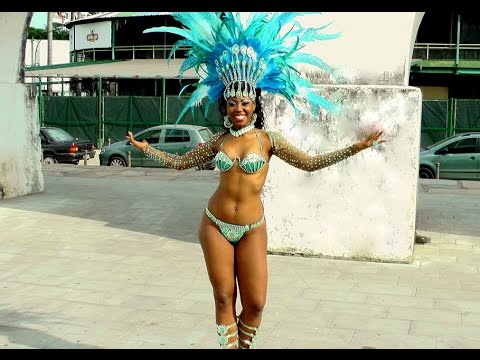
Above, Priscila Mathias, Passista.
"Passista" words comes from the Portuguese word passear - meaning to walk. They commonly walk, stroll and samba dance in front of the drummer sections. Dancer of a samba school, that knows how to choreograph the samba steps.
January 19th is Passista Day! It became a Bill number 4.462 by Valci Pelé 
Below are several definitions of a Passista:
"Passistas appear within the culture of samba schools as the recognition of women in the community who best represent the samba dance. These women basically have the role of defending their school's pavilion and winning the public's sympathy and admiration. Representing a school pavilion means representing an entire community, a region and the work of many, many people."

Passista sketch by pepeckt - DeviantArt

"The Passista wing is made up of girls and boys from the school communities, who show off the so-called samba-no-pé (samba in the foot) during the presentation. The group is formed, on average, by 20 of the best dancers in the association."

"With the role of enchanting and seducing the spectators, the passers-by bring a climate of joy and relaxation to the parade, while thrilling the other components, always encouraging the participation of the audience that accompanies the live show.

"Girls and boys from school who bring samba-no-pé with joy and relaxation. They play on the avenue and also encourage singing, exciting the other components of the parade. For girls, being a passista is the first step to becoming a Queen of Drums."

Above, Samba School Little League Filhos da Água, Rio de Janeiro, Brazil
First Official Reference of the Word Passista
The subject of the “passistas” became relevantly lately, not only within the samba/carnival business but abroad and a thesis paper was written in 2006, by SIMONE SAYURI TAKAHASHI TOJI student for a Master Degree in Anthropology. In this thesis paper, (the first official reference to the term “passista” – the individual that does the samba movement) - came out in newspapers around 1950´s, even though, other terms like “cabrocha”, which is a woman that possesses the samba dance art mastery skills, appears way before, in the 1930´s, with the development of samba and carnival itself.
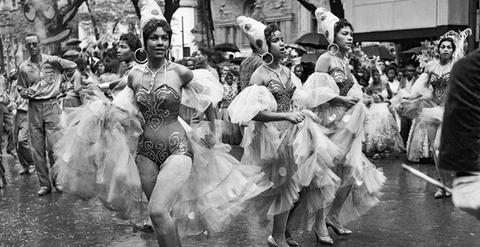 Above, an early photo of a group of women participating in a carnival parade, probably passistas of a local samba school circa 1950.
Above, an early photo of a group of women participating in a carnival parade, probably passistas of a local samba school circa 1950.
Still according to her studies, the first official “passistas wing”, was formed at Mangueira Samba-School, in 1972 by Drums Section Master Djalma Santos, and it was called “Vê Se Entende” – (See if You Understand) – in a free translation. But still, they did not parade or dance separately. Only by the 1980´s the “passistas” started to dance and present themselves at the Rio official parade in a fully separated wing.
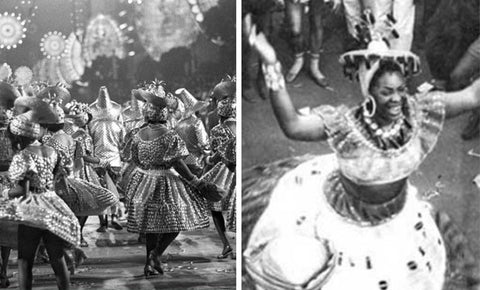 Above photos of Mangueira Samba School, and on the right famous passista dancer Nair Pequena that died while samba dancing during the Mangueira Samba parade.
Above photos of Mangueira Samba School, and on the right famous passista dancer Nair Pequena that died while samba dancing during the Mangueira Samba parade.
We translated parts of a fantastic thesis "Mulheres passistas de escolas de samba do Rio de Janeiro" written by Bárbara Regina Pereira .
She explains that the term "passista" came to be known only from the 1960s, in reference to the dancers, men and women, who presented "body performances similar to juggling". However, women always were present in the construction of what would become the samba dance. Since the called "batuques" (generic denomination of some afro-Brazilian dances accompanied by percussion and, sometimes, also chant), performed in the slave quarters or in the backyards of planters, they were key participants in making the demonstrations predominantly from African societies forced for the country, resulted in what we know today as samba: a cultural complex that brings together, among other elements, music and dance.
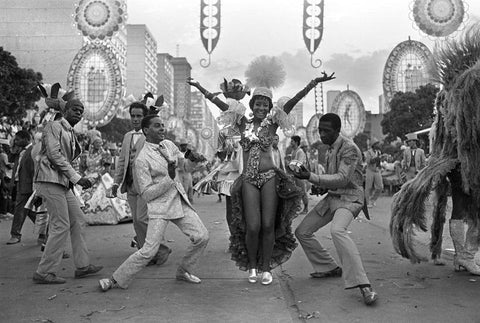
First References and the Samba Matriarch "Tia Ciata"
Carnival as we know it today exists largely thanks to the "tias"or "aunts", Bahian women who opened their homes for the "sambistas" meeting throughout the year and thus offered a safe space for them to meet without being chased by the police.
"Aunts" are the epicenter of this Carnival culture. "Their homes were spaces for socialization and protection," says journalist Bárbara Pereira, a doctor in social history from the Federal University of the State of Rio de Janeiro.
When, in 1932, the newspaper "Mundo Esportivo" organized the first parade on an official basis (before there was no competition between the blocks) the women were called cabrochas, they learned to dance in the samba circles that incorporated, among other elements, dances related to African religions,
especially that of the Orixás.
 Above, The Dance of the Orixás
Above, The Dance of the Orixás
The most famous were the "rodas de samba" (circles of samba) of the so-called “Aunts baianas”, whose most prominent figure was Hilária Batista de Almeida "Tia Ciata" (aunt Ciata).The matriarch received at her home in then Little Africa - where today is the region of "Praça XI", in Rio de Janeiro - representatives of all segments of society at parties that brought together musicians and their diversity of genres. But there were many others, says Pereira, who entered the historical record only as supporters of their husbands or were simply forgotten.
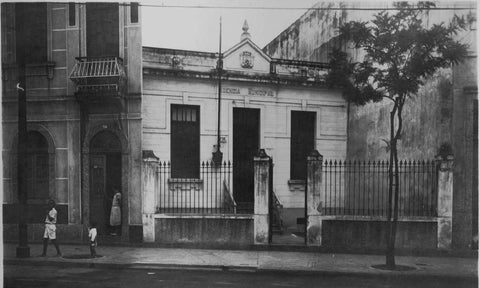 Above, the house of Tia Ciata
Above, the house of Tia Ciata
Above a movie about Tia Ciata
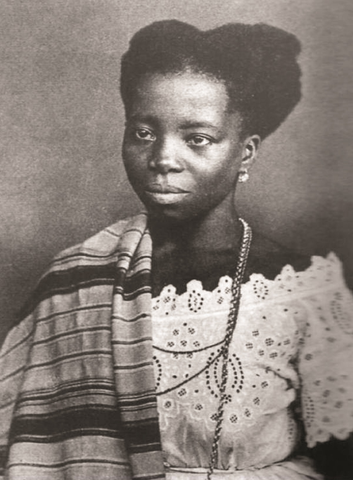
Above, photos of Tia Ciata dressed in typical "Baianas" outfits.
The trajectory of the samba genre, in fact, had a narrative based predominantly on male figures, but the women were not supportive in this process, they were, above all, ahead of important initiatives not only in culinary tasks, as shown in the historiography official, but also as agents promoting its culture.
In his work on the role of women in samba in the first three decades of the 20th century, the writer Gomes (2011) states that there are no documents proving Tia Ciata's participation in the music composition of "On the Telephone", the first samba to be recorded in 1916, although it is considered today a Maxixe. (Maxixe was the first type of urban dance to emerge in Brazil. It was danced in places that did not meet the morals and good customs of the time, as in forrós, "gafieiras" in the new city and in the cabarets of Lapa, in Rio de Janeiro, around 1875) (the word "gafieira" can also refer to the traditional samba music orchestra, as well as the dance hall where it is performed. The term gafieira was Brazilian Portuguese slang meaning "low dancing resort, gaff, honky-tonk" or "dance festivity frequented by the populace").

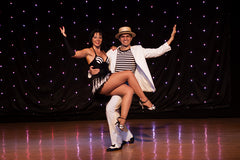
Above, photos of "gafieira" dance.

Above a typical Maxixe dance, courtesy of blog http://oblogdaginga.blogspot.com/2018/01/coco-lundu-e-maxixe.html
But, nevertheless, there are reports of frequenters at the house of Tia Ciata, planted in the region where many of the post-abolition black men and women settled, who guarantee to have seen her playing a guitar excellently, like the folklorist Mário de Andrade, a fact that does not prove the partnership in the creation of the composition, but that puts in check-mate the male hegemony in those meetings and, consequently, in the narrative of the cultural complex that today is understood as samba and its multiple aspects, such as the "samba de roda" (samba danced in a circle), the alto party and the samba-enredo (main samba plot music), all registered as heritage Brazilian immaterial ("Matrizes do Samba do Rio de Janeiro", Iphan, 2007).
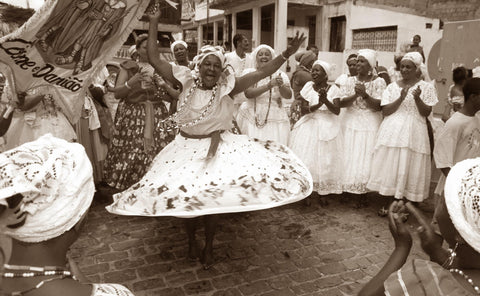
Above a "Samba de Roda" or Samba circle gathering.

Above a "Samba de Roda" courtesy https://www.sambando.com/jongo-o-ancestral-do-samba
Women Goes to the Avenue
Carnival would undergo a new transformation between the late 1920s and the early 1930s, when the first samba schools were founded - and with them, women began to conquer their own space in Carnival parades.


Above, women "goes" to the streets of carnival, photo early XX century
"The matriarchy in the history of samba has meant that there has been a significant female presence since the beginning of the schools, with the wing of the "Baianas" and the wing of the shepherds, who sang the samba-enredo together with the "puller" (singer), says the historian and writer Luiz Antônio Simas.
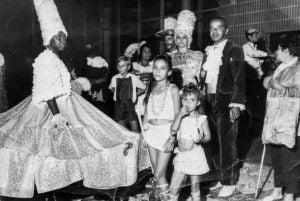
This paved the way for women to conquer other positions in the samba school parades over time. Simas points out that the first woman to come out on drums was Dagmar da Portela, in 1939.
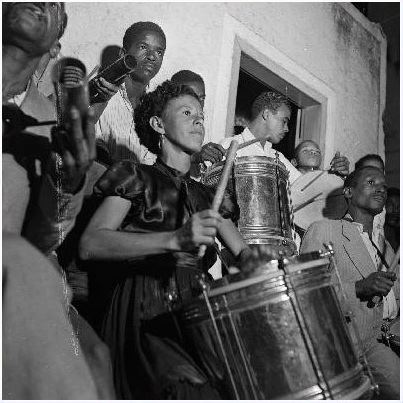
Above, Dagmar da Portela. Photo courtesy: Arquivo Público de São Paulo - Bateria da Portela (1954)
At the same time, women are gradually overcoming prejudice in samba schools by playing instruments considered "male", such as the deaf, the war box and the snare drum, and taking on the roles of carnavalescas, directors and drum masters, pullers and including presidents of associations. A "carnavalesco" is a planner and executor of the samba parades and other related carnival activities. "But there are still few in these positions, because the idea persists that there is a place for women and men in schools, especially in positions of power, such as the board of directors, and of more prestige, such as composition," says historian Marília Belmonte, who researches the old guard and the baianas wing of six samba schools in São Paulo.

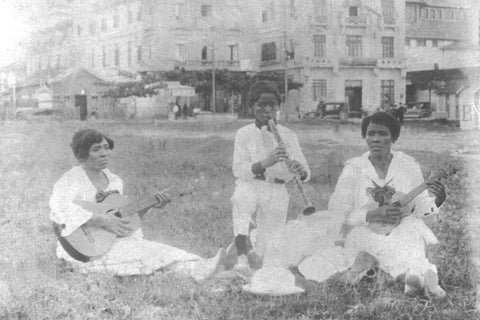
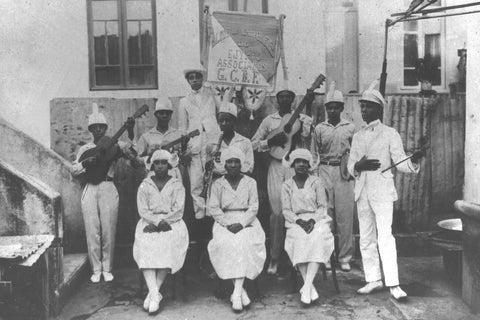
Above, beginning of the century, woman and children playing instruments and participating in the samba school parades with specific positions within a school.
The Role of Women in Samba
Although many women still participate in the countless existing processes in the construction of the carnival of samba schools in Rio de Janeiro, both the
trajectories of the party and of the samba schools themselves were told from the
views of men, either from the point of view of the narrators, or from the point of view of samba players themselves. The book "Serra, Serrinha, Serrano" by "Valença & Valença" (2017) show, from the history of the samba school Império Serrano, that there were women extremely active in the foundation of the school in 1947, whose names are not even mentioned in the minutes of its creation. However, their husbands are there, even if they did not get so involved in the activities as their companions.

Above, the book of Serra, Serrinha e Serrano by Valença & Valença
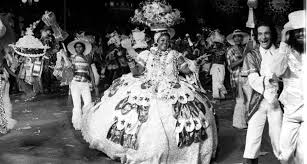
Above, photo from the book Serra, Serrinha e Serrano. A woman participating on the carnival parade in 1947.
This scenario leads us to question whether the place reserved for women in schools of samba would have been restricted to aesthetic exposure, in different ways, whether as Bahian, either as a highlight on a float, as a flag bearer or as passers-by (passista). Gonçalves (2010) reveals that the different groups, with representative or not positions of power, compete for spaces within the associations themselves, in addition to inserting themselves in games between the samba schools.
In the midst of the need to mobilize in front of different groups are the passistas, women with different motivations to become the target of looks - positive and negative - for their ways of expressing themselves at the parade carnival. Let's look now at the roles of the passistas in more recent decades.
Passista Show Woman or Mulatta Show Woman?
There is a need to differentiate the work of "passista-shows" or "mulatto-shows", as "the women who dance samba" in shows are called, or the women who only act as samba school dancers. After all, a passista can come to participate in shows, but not necessarily every passista will be chosen for participate in shows that have this manifestation as a central attraction. The activity "passista show" became a work alternative with the inclusion of these women in these forms of spectacle by entrepreneurs like Oswaldo Sargentelli (1924-2002), the best known among several who worked in this field. He was an Italian-Brazilian and worked in the radio as a young men and later on TV as a presentator of shows.There was a controversial show he used to present called "O preto no branci e o advogado do Diabo". (the black and white and the devil's advocate). However during the military regime, he was prohibited to continue presenting this show. That's when he started in the samba business. He opened the samba spectacle night club called "Sambão" in Copacabana. then "Sucata" and "Oba-Oba". These "passistas" were called the "Mulatas do Oba-Oba". Below we see a short clip of the "mulatas" on a TV show with samba singer Jair Rodrigues.
The Oba-Oba group would travel around the world as we see below on video at an Italian tour:

Oswaldo Sargentelli, entrepreneur and his famous passistas.
Unfortunately there was much female sexual objectification of these samba dancers, and many were promised samba performing gigs abroad leading them to discover a different reality, being exposed to scams or misleading "opportunities". These so called "producers" were promising a good salary to perforn in many countries. The reality was completely different....below is a small documentary that was exposed in 1980, in Portuguese, about these exploitations of the passistas abroad; a sad chapter in so many young woman's lives.
Above a video named "In 1980 the Brazilian mulatas were exported as sexual objects".
Below are some excerpts of a thesis written by Bárbara Regina Pereira (UNIRIO/RJ) that talks about this reality:
Female Objectification in Samba
The group of women who dance the samba, as professionals or
as members of a wing of dancers, had and has, in general, their associated image to exacerbated sexualization. The objectification of the female body in samba is a frequent debate, enhanced, among other factors, by the frameworks of television cameras during the parade broadcasts, giving sexualized connotations body movements that are characteristic of samba dance, in which the sensuality is part of the body movement game.
A sensuality that, as we have seen, carries traces of ancestry itself, since the dances of the female deities of the African-based religions - like Iansã,
the queen of the winds, and Oxum, the goddess of fresh waters, performed at candomblé parties or umbanda - were some of the bases for the construction of the samba dance, as reveals writer Rêgo (1996) below:
"Oxum's arms guide the rhythm of the body as if it were pulling the oars, now forward, now backward. She reproduces, equally, sensual stirring of the shoulders. Orixá of beauty, enchantment, too Oxum dances holding the skirt of the skirt, where she looks, as looking for the image of his grace in the mirror of the waters (sua saudação é ora iêê ô) (p.8)
Above, dance of Oxum.
The marked sensuality in body movements and clothing, which features the construction of the passista persona like bikinis decorated with sequins, sandals high heels and back piece, are factors that influenced the construction of the social imaginary in relation to the women who dance the samba, attributing to this form of artistic manifestation generally pejorative labels that disregarded the manifestation itself. Objectification is not something to be denied, after all the carnival industry used - and still uses - these images to “sell” the party as a tourist element.
Passista Today
Passistas typical start dancing at their community, or the samba school they are attached to, at very early ages. Of course, then they are not called “passistas”, just young girls dancing and having fun, watching the elders and older dancers But they already try to imitate the “big girls” as they call them, and specially, the “samba princesses or queens”. Some of these girls of 6-8 years old, then move up a step. At the samba-schools, older “passistas” provide “formal” classes to these girls, as part of a series of social activities that some of the larger samba-schools in Rio provide.

Later, according to their interest, they are invited to participate at a “children's wing” either at the samba-schools parade, like Beija-Flor, Mangueira, Imperatriz, Unidos da Tijuca, which have wing just for kids (with a special permit & presence by their parents) or they present themselves at the infant parade, which happens Friday, the real first day of Carnival in Rio.
Above a project from Imperatriz Leopoldinense Samba School "Projeto Passistas Mirim", Velha Guarda da Imperatriz, photo 2016.

Above, a competition for a young passista competition.
Passistas today are very different then they were in the past: Both at the samba-school, but also out of the samba-school. It is a consensus that very few passistas are able to sustain financially themselves just with a samba career.
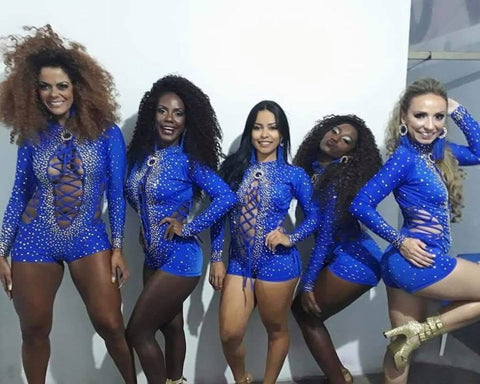
Passistas from São Paulo, wearing samba passistas rompers by BrazilCarnivalShop.
Most of the samba-schools have what it is called “Grupo Show”, which are Samba Dance Group shows and spectacles offered by the samba-schools to corporate events, parties, weddings, and even travel to other cities, states or countries.

Above, the elite team of Passistas from Beija-Flor Samba School.
Only the top samba dancers make it to this elite team, even within the samba-school. But even though, being part of a samba "group show", many are still unable to live exclusively by the samba dance, and have to establish themselves in professions as executive assistants, saleswomen, beauticians, etc. Many too, because of this unfortunate scenario, “flee” to other countries of the world and establish themselves there because of financial opportunities. So, it has been proven passistas still can´t live just upon their passion, which is unfortunate. Today thanks to the internet these elite samba dancers can travel around the world to teach samba classes, workshops at dance studios invited by local samba groups.

Above Karina Moraes, a respected Passista, Queen and Muse of Vila Maria, São Paulo. Costume by BrazilCarnivalShop
What it takes to be a Passista
Determination, love for the school, discipline and passion. To be a passista you need to be accepted by a major samba school, and there are even competitions, auditions and tryouts to get into a major league or a samba team. You will also see competition for fitness passistas, passistas beauty competition, and princess passistas competition. The participation of these professional dancers prior to the samba parades are extensive and extremely competitive. All over Brazil you will see the best professional dancers competing for a specific competition throughout the country and abroad. There are many events surrounding the passista world, from gatherings to even inviting groups of passistas from one samba school to visit another school. There are dedicated marketing and social media teams that will promote these events. It's a great way to have these passistas known and promote their image and dance.
Above a virtual passista competition presenting the finalist of the "1st Virtual Battle of the Passistas from São Paulo"
The samba schools like we mentioned before do have auditions for the passistas positions for the parade event itself. Even though the passista wing is the smallest one, it's the most competitive wing at a samba school. Usually its less than 60 dancers at a passista wing. To be in that team, you must be fully committed to attend all the rehearsals, buy the costumes, shoes, participate on all the events and be able to be a team player. This means that they not only have to have time to do all that but be financially able to buy their own costume and use specific samba shoes. There are still many stereotypes as to what a passistas should look, and how she should dance. That will depend on each school's overall philosophy or how the passista director/choreographer envisions that wing to look like based on what they want to achieve to win. It is to be noted that its is NOT MANDATORY to have a passista wing at the samba parade, however if there is a passista wing, they will be judged for their performance. Mostly they are looking for dancers that has a specific body type, however, this stereotype is slowly changing. You will see a mix of white, Asian, plus size, dwarfs etc.

Above, passistas plus-size project "Plus no Samba RJ" is a project that has as its main objective to regain self esteem. Here an article at a major Brazilian newspaper G1: https://g1.globo.com/rj/rio-de-janeiro/carnaval/2020/noticia/2020/01/17/projeto-de-passistas-plus-size-promove-inclusao-no-carnaval-do-rio.ghtml
Above the Instagram page of the PlusnosambaRJ.

Above, the well known dwarf Vivi Assis, parading for years as a passista as the muse of Embaixadores da Alegria Samba School. Here an article about her at G1 Newspaper: http://ego.globo.com/carnaval/2016/noticia/2016/02/vivi-assis-ana-do-carnaval-volta-sapucai-e-levanta-o-setor-1.html
Associations are getting stronger
One of the most challenging efforts today is to have this profession become fully funded by the samba schools, from providing water and food, to ensure they have full sponsorship on costumes and prototypes. Ultimately to provide them higher financial compensation is what this career needs to gain more respect and build a better future! Below is a couple of links to the "Passista Association of Brazil"; a respected association that is growing. It has its main objective as described below:
"AIMING to preserve, disseminate and strengthen the dance art of the Passista do samba (in their traditional and / or modern representations);
Defend the rights of passers-by as artists who represent a symbolic cultural value of Brazil, and fight for the respect and appreciation of this Art;
To be a link of unity throughout Brazil and abroad, for the passistas
On this date, January 1, 2021, Nilce Fran, Aldione Senna, Bruno Tete and Dhu Costa launched the Association of Passistas do Brasil “Ciro do Agogô”, a non-profit entity (Legal Entity) to organize the demands of this artistic class of samba dancers .The above video commemorates the Foundation of the Association, and has 42 dancers of all types, for the democracy of Samba no Pé dance.
Click below to be re-directed to their Instagram page:

Above, specific samba shoes used by passistas.
Another aspect is how they will samba. Since the 90's we have been seeing a change on how they will samba dance. "Samba no Pé" (samba on the feet) is a more freely style of samba, with lots of energy, very traditional. Some samba schools will allow the entire wing to be free and true roots to samba. Other samba schools will have a more choreographed wing. Overall the passistas are having a more choreographed team, and that trend is reflected on what is happening in the dance world or dance samba communities. It is a very interesting change, Samba schools like Vila Isabel, Paraíso do Tuiuti or Mocidade will allow a more free "samba no pé" for example.
Above a great video from our channel that shows the passistas in great footwork close-ups!
One of the most respected talent shows in Brazil are the King and Queen Passistas competition. This is an event that is promoted by the Mayor to pick the queen and king of the carnival parade. Usually this event is promoted and it takes place months before the carnival season. Not only a queen and a "Mommo King" is chosen, but also a "court" princess. It is a very competitive night, showcasing the best passistas of Rio, and the most amazing and expensive costumes you have ever seen. King and queen carnival competition generally are promoted by each city and draws a huge crowd. This will bring enormous status to the candidates. They have to participate on its official coronation on the "opening" of the Rio carnival and the mayor will give the Mommo King the "key" of the carnival season. A symbolic way to "open" the carnival season to come.

Above, Passista Fitness Competition - Passistas from Beija-Flor

Above, passistas from Paraíso do Tuiuti. Every year they have auditions to select the best 60 candidates to parade on the samba school parade wing of passistas. Photo Credit srzd.com


Above, passistas from União da Ilha Samba School and a flyer promoting the 1st encounter of the passistas from all other samba schools.

Above a flyer promoting the competition for the passistas and malandros "Nota 10" (Grade 10), São Paulo.

Above, a pageantry to elect the "Golden Passista" from UESP, São Paulo.

Above, a flyer to recruit passistas for the tryouts to participate on the samba school's wing of passistas. It's a very competitive position!


Above, photos on the beauty competition "Beleza 2020" promoted by the Special Group Samba School Organization. The passista Preta Coutinho was elected the most beautiful passista, from Viradouro Samba School.

Above, Queen Egili Oliveira, a respected professional passista samba dancer at the Queen and King (Rei Momo) competition
Above, a compilation of the Top 10 Samba videos for the Rio Carnival Queen Competition
https://www.instagram.com/egilioliveira/


Above, queen Marcia Gabriella, she is the daughter of passista queen Egili de Oliveira. She was elected the Queen of her city, Jundiai, 2020.
https://www.instagram.com/marciagabriellaaa/
Passista Samba Costumes and Accessories
The passistas around the world and specially in Brazil, are very specific on what they use to promote their dance and image. If the passista goes to a special event they will wear a "passista dress" and a "passista shoes". These outfits are specific for samba dancing and are made by the top carnival designers and cobblers in Brazil that will compete to dress a queen, princess or king. Passistas will be invited to perform samba shows, so they can use a dress or a costume. They will have their own wardrobe or have designer lend them a costume. Some passista will make their own bikini costume and dresses. Dressing up is very important as they will use their image and video to promote their trade.

Above, a typical passista dress, used in any important rehearsals....
For a complete "passista" dresses and shoes, please refer to our website:
https://www.brazilcarnivalshop.com/
As said before, most of them lived and where raised next to the samba-school they are closest to, in terms of location. Many see the dance, apart from the passion and love for the carnival, a chance to move up the social economiv status and be recognized as true artists, as we really think they are. We see this movement, but unfortunately only during the carnival period.travel
The Internet Gave Them Freedom
We see a trend that many well respected passistas/queens started having a fan club on social media, and can express themselves by teaching how to dance, make-up dance tutorial as they go "live" on social media and invite other celebrities to share their experience with them. This allows the world to see their work, their art and lifestyle. The passistas is able now to engage with their followers, drawing more "likes and shares. Those who learn english or spanish for example (or any other second language) can easily express themselves when interacting with their students and fan club around the world. The internet is a huge step that allowed the samba dancers to step outside their samba school and individually express themselves. Some passista will promote samba workshops and charge per class for example or ask for donations, thus making extra income. Many of these passistas can be hired for international samba school parades either as a guest, "Godmothers" or as a "parade queen". The internet allowed them to travel the world and be more independent from their samba schools. It gave them freedom, connected them to people and places that they would not normally go.


Above Passista and Samba Queen Egili Oliveira last year 2019 on a Samba Official Workshop Tour and at her community Moro de Santa Marta, Rio de Janeiro.
Later, most of them lead their regular lives and dance for pure pleasure, health and love for the carnival culture, without much glamour. Very few of them “make it to the top” of the economical-social status, unfortunately... We really think this must change, and society should recognize them and VALUE them as part of a national identity.
Age and Rising Stars
Most passistas´s age in a real top samba school average between 16 and 35, though more than ever older passistas are maintaing sculpural bodies making a number for age something of the past. As we all know, samba dance is extremely caloric spending and requires much energy. Practice sections last for 5-6 months, normally 2 or 3 times a week. Each session takes about 2 to 3 hours. So evidently it's a very physical and energy consuming exercise. During carnival season their dedications can go for days on end!

Above, Passistas from Unidos da Tijuca Samba School, rehearsing at the samba school gymnasium.
Rehearsals
The passistas rehearsals are located at the samba-school headquarters, the “quadra” (gymnasiums), and directed by a specific person, the passistas wing Director. As some passistas become older, a natural renovation process takes place each year at the samba-school, a new girls substitute older ones, or the one who abandoned for one reason or other. Many of the passistas then assume new roles within the samba-school structure, as samba teachers themselves, art coordinators, assistants and “harmonia” functions.
Above, passistas from Unidos da Tijuca Samba School.
Above, passistas at a the samba school headquarters, rehearsing for the parade.
Samba Dancing Costumes
Regarding the passistas costumes for shows, this topic too has dramatically changed along the carnival history. Passistas normally had in the past, more of what foreigners know as the “show girl look”, with skimpy bikini costumes. The passistas in the past used less clothing than the majority of the other samba dancers. Nowadays, a passista will invest in quality costumes and best material, premium feathers and high priced designers for their personal perfomance or gigs. Prized passistas will have a huge selection of costumes, however many will borrow or rent costumes for specific samba shows, competition, photoshoot or performances. Many passistas will even make and sell bikini costume as a side business and thanfully the internet allows them to become respected and well know in this side trade.

Above, a photo of Passista Layza Santiago. She won a passista competition for the TV show "Caldeirão do Hulk", a very popular passista competition, opened to all passistas.

Above gorgeous Sheila Neves, muse of the drum school "Camisa Verde e Branco" from São Paulo. Notice that she has a spectacular pheasant back piece mixed with the bottom portion "goat's beard", a more natural and vegan approach to costume making. We sell goat's beard on our shop.
Passista Wing at the Carnival Parade
In the last 30 years, due to the new carnival parade aesthetics and dynamics, more clothing was “imposed” on the passistas wing for carnival parade, as to leave them with a greater similarity of the traditional wings. Lots of feathers, shoulder pads, specific "Carmen Miranda" samba shoes and adornments were added at the top schools. A typical passista will use a "Carmen Miranda" shoes, that has a heel and a platform. During a typical parade, all the passistas will use the same style of shoes. In this link we talk about the official samba shoes: https://www.brazilcarnivalshop.com/blogs/news/the-history-of-samba-platform-shoes .

Above, a typical samba shoes used by all level of passista dancers from all over the world. These shoes can be found at our shop: https://www.brazilcarnivalshop.com/collections/open-toes-shoes/products/carmen-miranda-straps-professional-samba-shoes?variant=19076503765061 It's the Classic Carmen Miranda Shoes.

Passista Wing of Salgueiro Samba School.
All of them who we have spoken with admitted their desire to samba dance “as freely as possible” in a parade, with less choreography, more "samba no pé" (samba on the foot) in order to facilitate movements and body language. Only recently carnival designers are reviewing this demand and again trying to settle a compromise with the luxury of clothing and the “lack of clothing”, but always adding of course some spice to this treasured wing. Less adornments allows the passistas to dance more freely in their samba moves. The more covering the more restricted they feel when dancing. As a reminder, the passista wing is not mandatory in a samba school parade.
Passionate Elite Samba Dancers
All in all, hope and passion is what maintains passistas in their lives! The greatest carnival show on earth would never happen without the passistas “magic”. They make a total difference on the parade, rehearsals, street carnival, and other events.
Passistas are today in our vision the elite of the samba dancers and samba dancers around the world look at their skills to learn and to be inspired.

Above, Passistas from Unidos de Padre Miguel
Nobody today could avoid associating Brazilian Carnival without their ubiquitous presence. Passistas, just like Hollywood celebrities in the United States, are able to provoke dreams, folklore, passion to even the most skeptic minds and souls.
Let's take the opportunity to celebrate their existence and mystery and hope they are finally recognized in Brazil, for the sensational contribution they make to its culture and society. The passistas are at the core essence of carnival, just like the drums section, the Baianas, the flag bearer (Porta-Bandeira) and the samba-host (Mestre Sala). In our humble vision, the "passista" section" during the parade should open the carnival parade! Glory for the soul hearted passistas!
In our next blog, we will talk about the Historical Passista Dancers!











